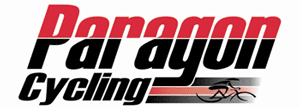New To Triathlon? Start Smart!
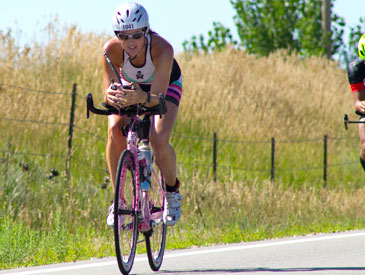
The butterflies in your stomach flutter incessantly in the pre-dawn dark as you prep your bike and running gear in transition one. The cold water sends shivers from your toes up through your body as your age group is called to the line. Then, the bang of the starter's gun sends a jolting shot of adrenalin through your veins. The sensations of your first triathlon will remain with you forever, which is why it’s so easy to get hooked on this sport.
Triathlon also tends to be easy to get into, because it's comprised of the three popular sports, swimming, biking and running. Chances are good you already know how to swim, have biked and run some, like cross-country or track in high school or college. If so, you're probably already good at one of the triathlon disciplines and you can easily do the other two to finish your first tri.
You'll quickly discover the satisfaction of completing three different sports back-to-back. And, you've never been fitter in your life than when you are triathlon race-ready, since the sports complement each other and build your whole body.
To help you get into this fantastic sport, we've prepared this introductory guide. Plus we've got the tri gear for you to do your best, too.
History
Triathlon grew out of early 20th century France, with varying-named events that involved swimming or canoeing, cycling, and running, though not necessarily in that order. But it wasn’t until 1947 that the San Diego Track Club put on the first modern triathlon in Mission Bay, California.
1978 marked the year of the first Ironman, held in Oahu, Hawaii. While it now takes place in Kailua-Kona, Hawaii, it's the Ironman with its 2.4-mile swim, 112-mile bike and 26.2-mile run that comes to mind when the average person thinks of triathlon. And, like that famous event, modern triathlons usually include swim, bike and run legs, in that order. While that's the traditional event, you'll still find other triathlons like Xterras where you race partly off-road and even some events involving canoes and kayaks, still. Plus, some tris include team categories so that if you love only one of the three sports you can round up friends to do the other legs and compete as a team. Great fun!
The course
For traditional triathlons, there are four standard triathlon course lengths: Sprint, Olympic, Half, and Full. Although, there are a few in-between races, as well as a select group of masochists out there that compete in Doubles or Ultras, which are 282.2 miles long (422km)!
Here are the distances of each leg in the standard triathlons:
Sprint: 750-meter swim (.47 mile), and typically held in a pool, which is followed by a 20km bike (12.4 miles), and a 5km run (3 miles).
Olympic: 1.5km swim (.9 mile), a 40km bike (24.9 miles), and a 10km run (6.2 miles).
Half, also called a 70.3: 1.2 mile swim (1.9km), a 56 mile bike (90km), and a 13.1 mile run (21km).
Full, also called an iron-distance or the well-known and branded Ironman: 2.4 mile swim (3.9km), 112 mile bike (180km), and 26.2 mile run (42km).
In all triathlons there are two transitions: one from swim to bike and one from bike to run, both of which count towards your cumulative time. During transitions you switch from swimmer to biker and from cyclist to runner. So, depending on your race clothing preference and how the race organizers setup the transitions, you typically get out of your swim gear and switch into your bike kit, grab your bike and hit the road in T1 (transition 1) and then, drop off the bike, switch into your running shoes and start the run leg out of T2.
The person who completes the course in the fastest time wins. So speedy transitions are important if you're racing to compete, and finding ways to save time during them is important if you're going for wins.
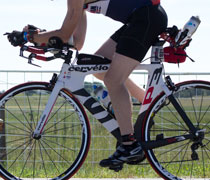
Training versus equipment
With three sports in one, you might conclude that a lot of high-priced equipment is necessary, as well as a serious dent in your next dozen pay checks. This is only true if you want it to be. For your first triathlon, or even your first few, having the most expensive equipment usually isn't that important because you're getting used to a somewhat complicated new sport. For example, you might save a few minutes with a set of deep-dish aero wheels, though on the other hand you might have to grab the brakes more often when a gust of wind picks up and pushes those sail-like wheels around.
Instead, to start, you need practice more than the fanciest gear. You need to get used to the transitions and figure out which event is your best and what you need to do to improve in the events that aren't your best. Sometimes equipment adjustments help, but often, just using what you have more will do the trick.
Fast equipment does become more important the more experienced you get, because of the diminishing gains from training, but until then, it's wise to focus on the essentials. Consistent training, growing accustomed to the equipment you have, and practicing small things like your transitions will make a much larger, and less expensive, performance boost. Triathletes are nice people, and you can learn a lot by watching and asking other tri gals and guys for their advice.
TRIATHLON EQUIPMENT
Triathlon bikes
While you can use any kind of bike in a triathlon, even a mountain bike if you so choose, the fastest and most widely accepted type is a triathlon-specific bike. These will save you heaps of time. Note that they are more difficult to handle than a standard road bike, so plan on some practice time to get comfortable riding them.
Tri bikes are outfitted with aero bars and pads to rest your forearms on, resulting in a low, aerodynamic position that lets you poke a hole through the wind for free speed. Comfort is vital as well, so when setting up your position remember that you’ll be in it for up to hours at a time. We can help fit you to your bike.
A triathlon bike generally has wide, aerodynamic tubing, short chainstays, an ergonomic seat, gearing for the hills and flats, powerful brakes, lightweight wheels with fast-rolling tires, and occasionally, a hydration or nutrition storage unit built right into the frame. We have a nice selection of tri bikes and accessories, in various price points and are always happy to show you the differences.
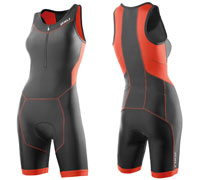
Triathlon kits
Since triathlons start in the water, it's best to wear a triathlon-specific kit (the body suit or combination of your shorts and singlet). It can be worn alone and it fits underneath your wetsuit (for triathlon courses where they're allowed). It keeps you fluid-dynamic and aero for efficiency in the water and on the bike, and it dries fast. It's also comfortable for swimming, riding and running.
These suits generally have pockets in the jersey for food, sleeveless arms for mobility, and a smaller chamois pad that won’t absorb as much water, stays comfortable while you're riding in the aero position, and won't cause chafing during the run like a cycling-specific chamois can.
Note: if the swim water temperature is above 76.1 degrees, you will not be allowed to use a wetsuit or have any clothing covering your shoulders. This is another reason why triathlon suit jerseys are sleeveless.
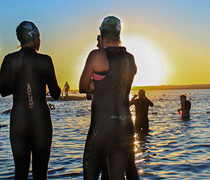
Wetsuits
A well-fit, long-sleeve triathlon wetsuit saves roughly 10 seconds per 100 meters during the swim. It helps keep you buoyant, your legs floating up high, and makes you more streamlined. Not only that, if the water is chilly it saves you precious energy that would otherwise be zapped by the cold water.
Hydration systems
Staying well hydrated during the longer events (the Half and Full) is a challenge, especially if your triathlon bike only has one bottle cage. There are various solutions though, including aerobar-mounted straw systems, frame-integrated drinking systems, rear seat-mounted bottle cages, or even hydration packs.
Above all, make sure you know how to use whatever system you plan to rely on come race day. Practice using it during training so that you can drink while riding a straight line and remaining in control of your bike. You'll get the hang of it quickly.
Nutrition
Like hydration, replenishing lost calories during longer events is vital. You’ll even benefit from race calories during the shorter events. For the longer ones, a good rule is to consume between 200 and 400 calories per hour.
Most of these calories should come from high-glycemic carbohydrates, as they’re the easiest on your stomach to digest and the fastest to reach your blood stream. Like your hydration system, make sure to train with many of the same foods as you plan to use on race day to ensure you can stomach them.
In addition to food nutrition, a good high-salt/lower-sugar drink mix is especially beneficial for longer, hotter races. Aim for a product that has 100-200mg of sodium per 8-ounce serving.
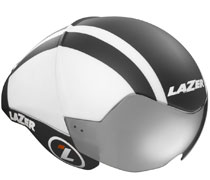
Aero helmets
We’re getting to the less crucial equipment here, but if you can afford an aero helmet, it’s well worth it. The time saved with one of these adds up pretty heavily over the bike leg.
Make sure to pick one that fits well and doesn’t inhibit your vision when you’re low in the aero bars. It’s also important to pick one that is well ventilated, as overheating will negate any time saved through aerodynamics.
Shoes
If you're just starting out, you can race triathlons in one pair of shoes that work for cycling and running. But, as soon as you feel more competitive, you'll want to get dedicated cycling and running shoes.
For cycling shoes, traditional road shoes work just fine. Yet, you may eventually consider purchasing triathlon-specific models with quick-closing Velcro straps, easy on/off features, and more ventilation. This makes transition times faster and keeps your feet drier after the swim.
For running shoes, it's the same. Normal running shoes will certainly get the job done. However, you may wish to at least swap your laces out with bungies or silicon bands for faster transition times. Lots of triathlon lacing options exist.
Or, you might want tri-specific shoes, which boast features, such as sewn-in footbeds for more protection and less friction in case you opt to ride and run sockless—another trick for decreasing your transition time.
Other essential gear, or items worth considering
-Swim suit and goggles—for all that pool training
-Pool "toys" (depending on where you swim, you may need your own swimming gear, like kickboard, hand paddles, etc. for working on your technique)
-Training running shoes—so you can save your lighter, faster ones for racing
-Training running shorts, tops—for protection and comfort training
-Eyewear that works for biking and running and UV protection anytime you're outside
-Training cycling clothing, like shorts, jerseys, leg and arm warmers, jackets and rainwear—for putting in the miles and getting stronger and faster on the bike leg
-Take-along toolkit, spare tube and pump—for the bike so that you can fix your own bicycle and get home in the event of a flat tire
-Energy food and drink to consume before, during and after workouts—since you'll need to keep yourself fueled and hydrated
-Anti-Chafing Stick—to protect your neck from the wetsuit during the swim and to protect your underarms during the run
-Wetsuit Body Lube—to ensure your wetsuit comes off as quickly as possible
-Gear bag for keeping your gear organized—for easy access at home and at the races
-Digital or print training journal to keep track of your swims, rides and runs—so you can learn what works and what doesn't, and fine tune your training to do your best
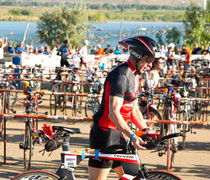
Beginner training tips
There are plenty of books and online articles with good training advice and training plans for your first triathlon. Here are some basic tips from us:
1) You should shoot for a variety of workouts within the week. Don’t spend a month riding, then a month swimming, then a month running. A mix of all three throughout each week ensures that you’re constantly improving in each sport.
2) If you have a typical 9-5 work schedule, it makes sense to do shorter workouts like swimming and running during the week, and to enter the weekend with fresh legs so you can maximize your time on the bike. Because it's proportional to the length of each event in the triathlon, you’ll spend approximately half your time training on the bike, a quarter in the pool, and a quarter on the run; depending on your areas of weakness and what needs the most improvement.
3) Another key element to a successful triathlon is completing a few "brick runs." This refers to a run done right after a bike ride, with minimal time in-between. Your legs will most likely feel like bricks, hence the name. It’s important to know how your legs and mind will respond on race day, and brick runs prepare you mentally and physically for the high demands of running after a hard ride. Likewise, once you're strong enough in all three events, you can occasionally park your bicycle at the pool, so that you can do your own training tri. The idea is to swim, bike and run to get used to doing them after each other, plus you get to practice your transitions, too. It's not the same as racing, but it really helps build your confidence and prepare you for the real thing.
Training and having working, familiar equipment for your race are vital for success. If you take away anything from this article, it’s to decrease the number of unknowns on race day. Practice open water swims, practice taking your wetsuit off as fast as possible, practice drinking from your hydration system, do plenty of brick runs, training tris, and even practice doing transitions to ensure they go as smoothly, and as stress-free as possible. Most of all, have fun!
Please let us know if you have questions about bicycles, clothing, accessories, components and training. And best of luck!
